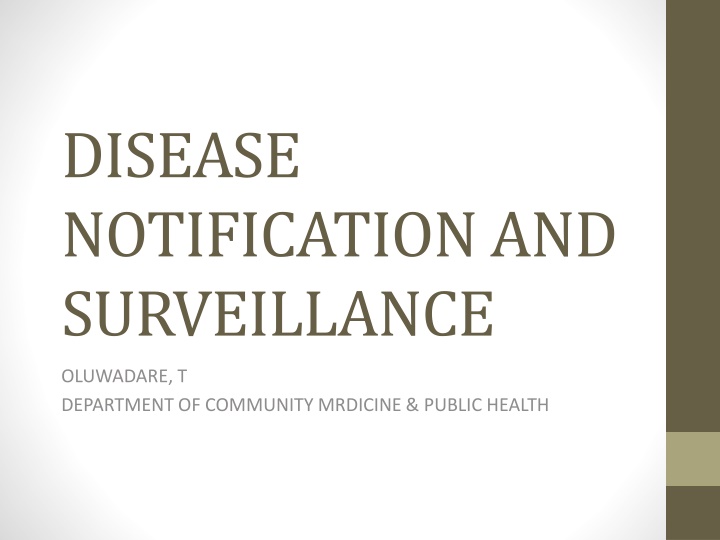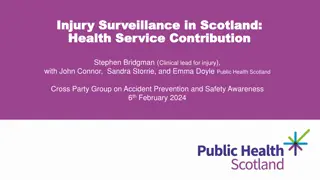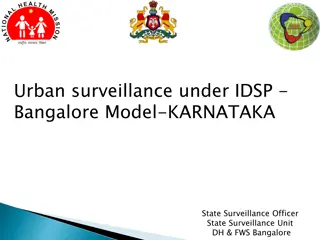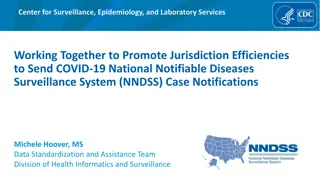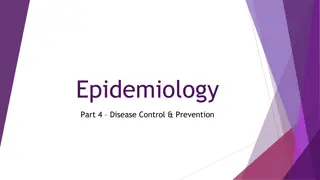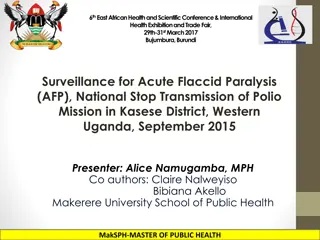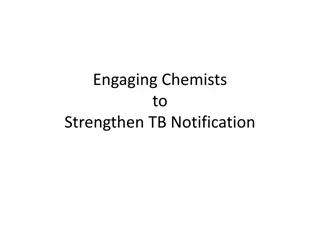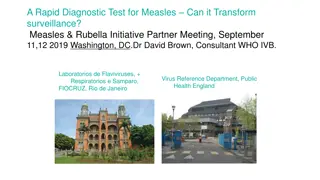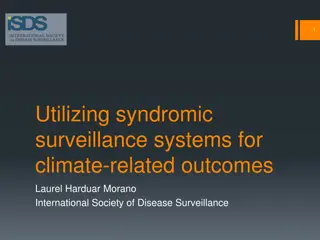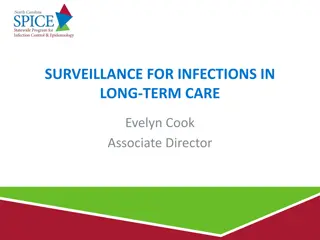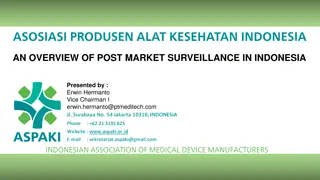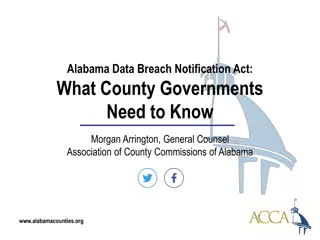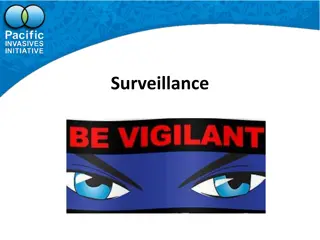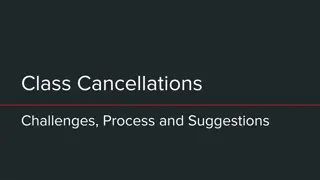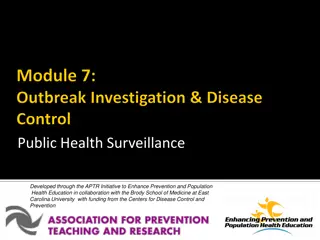DISEASE NOTIFICATION AND SURVEILLANCE
Surveillance and notification play vital roles in tracking, reporting, and preventing the spread of diseases within populations. This comprehensive system aids in early detection of outbreaks, informing public health policies, and ensuring timely interventions to mitigate health crises.
Download Presentation

Please find below an Image/Link to download the presentation.
The content on the website is provided AS IS for your information and personal use only. It may not be sold, licensed, or shared on other websites without obtaining consent from the author.If you encounter any issues during the download, it is possible that the publisher has removed the file from their server.
You are allowed to download the files provided on this website for personal or commercial use, subject to the condition that they are used lawfully. All files are the property of their respective owners.
The content on the website is provided AS IS for your information and personal use only. It may not be sold, licensed, or shared on other websites without obtaining consent from the author.
E N D
Presentation Transcript
DISEASE NOTIFICATION AND SURVEILLANCE OLUWADARE, T DEPARTMENT OF COMMUNITY MRDICINE & PUBLIC HEALTH
Introduction Surveillance is the continuous scrutiny of the factors that determine the occurrence and distribution of disease and other conditions of ill-health . Notification means alerting, telling and warning of imminent health crisis.
Introduction contd. Disease surveillance refers to the ongoing and systematic collection, analysis, and interpretation of health-related data essential to public health practice. Disease notification involves the official and timely reporting of the occurrence of specific diseases and conditions to designated public health authorities by concerned health workers for action using designated reporting tools.
Introduction contd. Disease notification is an important source of data collection for an effective and efficient disease surveillance system. Disease surveillance and notification (DSN) have been recognized as an effective strategy for the prevention and control of diseases especially epidemic prone diseases. In Nigeria, surveillance and notification of diseases involve the immediate notification of epidemic prone diseases, diseases targeted for elimination and eradication and monthly notification of other diseases of public health importance
Introduction contd. An effective and efficient disease surveillance and notification system allows early detection of disease outbreaks that will prompt intervention for the reduction of morbidity and mortality that may result from the epidemics of these infectious diseases. Levels of disease surveillance and notification can be individual, local, national and international. National disease surveillance and notification system often depends on effective district/Local Government Area (LGA) disease monitoring and control mechanism with the involvement of health workers.
Introduction contd. Objectives of surveillance To provide information about new and changing trends in the health status of a population Detect disease outbreaks & prevent further spread of disease Increase our knowledge of risk factors contributing to disease development To provide feed-back which may be expected to modify the policy and system itself and lead to redefinition of objectives Provide timely warning of Public Health disasters so that interventions can be mobilized
Introduction contd. Attribute of an effective surveillance system Sensitivity: How many of the people reported with a disease actually have the disease. Timeliness: How quickly are we being notified of a disease, initiating control measures, completing case reports, etc. Representativeness: Does X hold true for the whole population Simplicity: Is the system easy to use Flexibility: Can we make changes to the system easily Data quality: How accurate are the data in the system? How often are the data missing, incomplete or incorrect?
Introduction contd. The major types of surveillance Active surveillance Passive surveillance
Introduction contd. The major types of surveillance contd. Passive surveillance Passive disease surveillance begins with healthcare providers or laboratories initiating the reporting to state or local officials. Reportable diseases are submitted on a case-by-case basis, based on a published list of conditions. Passive surveillance is effective because it casts a wide net and can be more easily conducted on an on-going basis. It is useful for routine surveillance activities.
Introduction contd. The major types of surveillance contd. Active surveillance Active disease surveillance is when state or local officials actively search for information by contacting healthcare providers, laboratories, schools, nursing homes, work places, etc. Active surveillance should be used to investigate diseases with a high risk to the public's health, but it can also be resource intensive. Data collected through active surveillance generally provides more accurate and complete information than passive surveillance.
Introduction contd. Other types of surveillance Risk factor surveillance: It might be used to identify an increased risk illness due to specific environmental, behavioral, or biological elements. For example, the state department traps mosquitoes every raining season and test them for West Nile virus to determine if there is a risk to humans in a particular location Outbreak surveillance: Is mostly active and is used to find additional cases to pinpoint the source of the outbreak. This includes finding and interviewing individuals that contracted the disease to detect commonalities. .
Introduction contd. Other types of surveillance Sentinel surveillance: Is useful when the goal is to collect information on disease trends rather than individual cases. For example, a network of healthcare providers or hospitals is recruited to regularly report health events or diseases that disproportionately affect specific population or communities.
Introduction contd. Other types of surveillance Syndromic surveillance: Might be used to identify illness clusters early (even before diagnoses are confirmed and reported) in order to mobilize a rapid response. It programs various kinds of syndromes, such as respiratory illness or gastrointestinal illness.
Introduction contd. Brief history Disease surveillance and notification was introduced in Nigeria in 1988 following a major outbreak of yellow fever in 1986/87 which claimed many lives in the country and also affected ten out of the then 19 states of the country. Prior to that time, there was no coordinated system of disease reporting and surveillance in the country, as some states were sending weekly, some were sending annual report and others not sending at all.
Introduction contd. Brief history contd. This became a major cause for concern as it resulted in denied access to health information needed for timely response to disease outbreaks. As a result, the National Task Force on Epidemic control was set up to find a lasting solution to disease notification in the country. The National Task Force identified poor disease surveillance and notification as a major national problem and as an important constraint to effective disease control in Nigeria.
Introduction contd. Brief history contd. At the onset of its establishment, 42 diseases were officially designated as notifiable for routinely monthly reporting. The current DSN system in Nigeria was approved for adoption by the Nigerian National Council on Health in 1989.
Introduction contd. Brief history contd. In September 1998, the 48thWorld Health Organization Regional Committee for Africa met in Harare, Zimbabwe with the resolution of all member States (adopting the Integrated Disease Surveillance and Response (IDSR) as a regional strategy for strengthening the weak national disease surveillance system in the African region. The aim of the scheme is to integrate multiple surveillance system to enhance early detection of outbreaks of diseases in the Africa so that human and other resources can be used more efficiently and effectively.
Integrated Disease Surveillance Response(IDSR) Integrated Disease Surveillance and Response (IDSR) is a strategy and a tool to promote rational use of resources by integrating and streamlining common disease surveillance activities. Since 2001, Nigeria has collected information on epidemic-prone and other diseases of public health importance through the Integrated Disease Surveillance and Response system (IDSR). Currently 23 diseases are designated as notifiable through IDSR.
IDSR contd. The present IDSR strategy in Nigeria is well coordinated and combines available resources to collect information on notifiable diseases from a single focal point at each level (Community, health facilities, LGA, State and Federal) compared to the previous vertical disease surveillance system where scarce resources are divided among several disease control programmes. The LGA level is the main focus in the IDSR system in Nigeria because it is the first level in the Nigerian health system.
IDSR contd. These diseases have been grouped into three categories; epidemic prone diseases, diseases targeted for eradication and elimination and other diseases of public health importance . The current list of the Nigeria IDSR notifiable diseases, conditions and public health events are subjected to review.
List of Nigeria Integrated Disease Surveillance and Response (IDSR) notifiable diseases, conditions and public health events
The Integrated Disease Surveillance and Response (IDSR) reporting forms and their uses
The Integrated Disease Surveillance and Response (IDSR) 001A form-immediate case-based reporting form for immediate reporting of notifiable diseases (it should be noted that this form is sent immediately to the Local Government Area (LGA) Disease Surveillance and Notification Officer at the LGA Primary Health Care Department) after completion for prompt action
The Integrated Disease Surveillance and Response (IDSR) 001B form-Lab request form for immediate reporting of notifiable disease
Flow of Integrated Disease Surveillance and Response (IDSR) data in Nigeria
World Health Organization and Federal Ministry of Health recommended surveillance case definition for immediate reporting of selected notifiable diseases *Case definitions are a set of uniform criteria specific to each reportable disease and used for national reporting and surveillance purposes.
Challenges of disease notification & surveillance Underreporting - Most surveillance systems are passive and rely on the active participation of busy healthcare providers and under-resourced health departments. Incomplete data - There may be lack of cooperation by the patient, inability to contact the patient, inability of the patient to recall activities or potential exposures, or inaccurate information in the record.
Challenges of disease notification & surveillance contd. Reporting bias Cases are more likely to get reported when they are symptomatic vs. asymptomatic. Media coverage, more severe or rare conditions, and those with new diagnostic technology are also sources of reporting bias. Changing reporting criteria Reporting criteria are updated as needed, sometimes as often as every two years. Changing laboratory tests Some laboratory tests are more useful than others. Untimely
